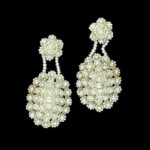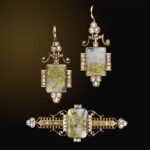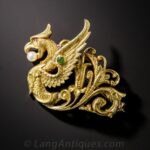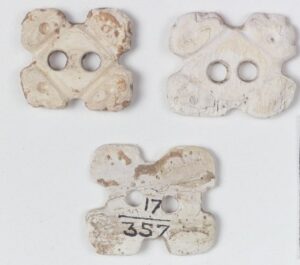
c.1500-1600, Florida.
Photo Courtesy of the National Museum of the American Indian
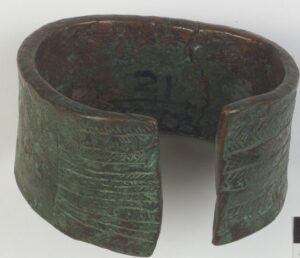
c.1700-1800, Ohio. Photo
Courtesy of the National Museum of the American Indian
Natives of North America, in the time before European exploration, adorned themselves with shells, bones, feathers, teeth and other found objects. Migration resulted in tribes exchanging materials not native to a given area. This resulted in turquoise and copper and other items being used in areas where these materials would not ordinarily be found. Seashells also traveled from coast to coast. European explorers brought jewelry and glass trade beads with them in their travels and these quickly found their way into use in Native American adornment.
Rumors of gold and riches in America caused an influx of goldsmiths, jewelers and refiners to arrive among the early settlers of North America. They soon discovered that the materials needed to practice their craft were not indigenous to the colonies and they had to rely on trade to bring them what they needed. As a result, most early colonial jewelry was imported, usually arriving in the new world as property of the settlers.
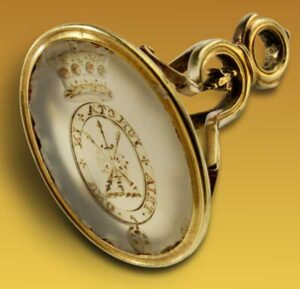
(Governor of Virginia c.1750s-60s).
Photo Courtesy of The Colonial Williamsburg Foundation
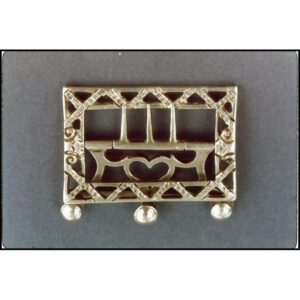
c. 1760.
Photo Courtesy of The Colonial Williamsburg Foundation
The jewelry that arrived in America with the early settlers was a source of negotiable wealth and the style and materials used were dictated by the country the colonists came from. Seals and signet rings were an early popular jewelry item because of their practical use in establishing the wearer’s identity and usefulness for marking documents and correspondence. Gentlemen wore seals suspended from their watch chain and women wore them suspended from a chatelaine. Signet rings, which served the same purpose, were worn mainly by men.
In addition, gentlemen wore decorative buttons, buckles (at the neck and knees and on their shoes), and watches with seals, fobs, chains, and keys. They carried decorative silver swords and gold-topped canes. Ladies usually counted a pearl necklace and beads of jet, amber, bone, coral, glass, and jasper among their belongings. In addition, hair combs of ivory and tortoise were popular along with rings and brooches.
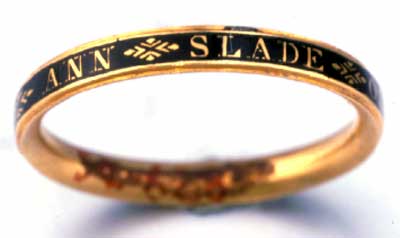
c.1767.
Photo Courtesy of The Colonial Williamsburg Foundation
Traditions from the “old country” arrived with the settlers. Mourning jewelry of all kinds, including the custom of funeral rings, found their way to the new world. Coffin-shaped stones, skeleton motifs, locks of hair, and pieces with black enamel along with the engraved name of the deceased or loved one were as popular in America as in Europe.
Gimmel rings and posy ring engraved with sentimental inscriptions were abundant but wedding rings were the most commonly stocked jewelry of the Colonial Era. Fancy jewelry included Giardinetti – flowery rings, brooches, and spray pins – that could be worn as aigrettes or brooches set with garnets and other colored stones and diamonds. Stomachers designed as large floral sprays, seemingly more appropriate for wear at European courts, also found their way to America.
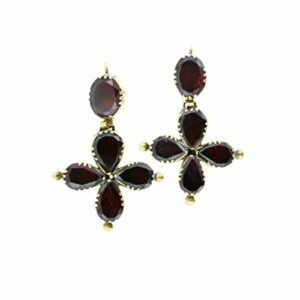
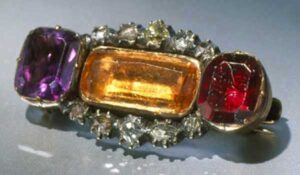
c.1700s.
Photo Courtesy of The Colonial Williamsburg Foundation
Garnets were one of the most commonly found gemstones in colonial jewelry. They enjoyed wide popularity throughout Europe during the Eighteenth century and elaborate suites of garnets found their way to the colonies. Martha Washington was particularly partial to garnets and amassed a large collection during her lifetime which included necklaces, an aigrette, earrings, rings, and brooches.
Pearls and mother-of-pearl were essential to every woman’s wardrobe. Native Americans made jewelry from the abundant freshwater pearls found in North America although these pearls were small and often times not very lustrous. Pearls from the Persian Gulf and the Pacific and Indian Oceans were considered the most desirable and beautiful of gems. Whatever the source, however, pearls of all types were found in earrings, necklaces, rings, and brooches just as they are today.
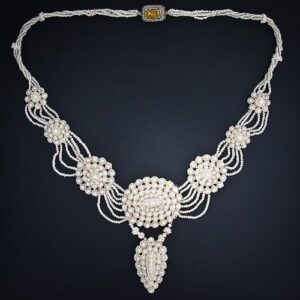
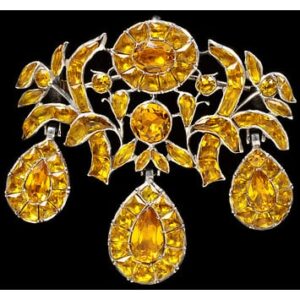
c.1740.
Photo Courtesy of Victoria & Albert Museum Collection.
Trade with India and Brazil during the eighteenth century brought diamonds to Europe and trade with the colonies brought them to America. Rings, earrings, buckles, necklaces, brooches and lockets set with diamonds were sought out by the colonists. Early on, most diamond jewelry was imported already manufactured but, during the colonial era, some of the more enterprising jewelers began to import diamonds directly and advertise custom-made diamond jewelry as well as their ability to repair it.
The not-so-wealthy imitated this love of diamonds with paste, wearing all manner of paste jewelry to imitate them. Paste could also be foil backed to imitate colored gems such as topaz and amethyst. Another colorless gem, rock crystal quartz, was also a popular diamond simulant. In addition to being used to imitate diamonds, quartz could be used as a clear cap over ciphers, enamel pieces, pictures, and many other items.
Jewelry for the wealthy was made from silver and gold, and metals for the less well-to-do included pinchbeck, pewter, brass, and steel.
Timeline: Part I
| Name/Period | Year | Company Info | Specialty |
|---|---|---|---|
| Jeremiah Dummer (1645-1718) Boston MA  | 1693 |
|
|
| Frances Richardson (1681-1729) Philadelphia PA  | c.1700 |
|
|
| James Boyer (1700-1741) Boston MA | 1722 |
|
|
| William Cario (1712-1769) Boston MA | 1735 |
|
|
| Alexander Kerr Williamsburg VA | 1737 |
| |
| John Paul Grimke Charleston SC | 1741 |
|
|
| James Craig Williamsburg VA | 1746 |
|
|
| Daniel Parker (1726-1785) Boston MA  | 1752 |
|
|
| Charles Dutens Philadelphia PA | 1753 |
|
|
| Joseph Richardson Daniel Christian Fueter (1720-1785) Philadelphia PA New York NY | c.1757 |
|
|
| c.1760 | c.1760 |
|
|
| Paul Revere (1734-1818) Boston MA  | c.1760s |
|
|
| c.1763 | c.1763 |
|
|
| Charles Oliver Bruff (1735-1817) Maiden Lane New York NY 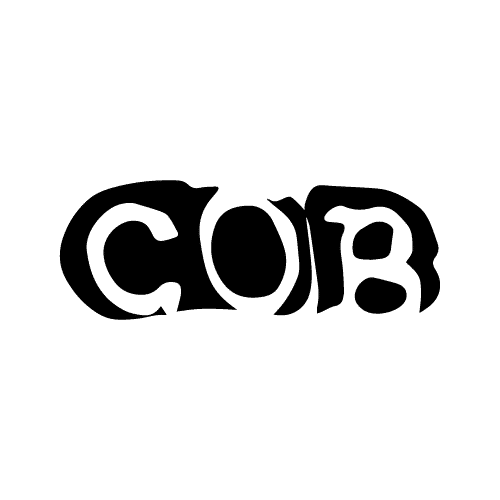 | 1763 |
|
|
| Otto de Parisen New York NY | c.1763 |
|
|
| William Whetcroft Anapolis MD | 1766 |
|
|
| James Bennett New York, NY | 1768 |
|
|
| John McFarlane Boston MA | 1769 |
|
|
| George Dorwig Baltimore MD | 1773 |
|
|
| Christopher Hughes and Company Baltimore MD | 1773 |
|
|
| American Revolution | 1776 |
|
More American Jewelry
Notes
- Proddow & Healy, p.12↵
